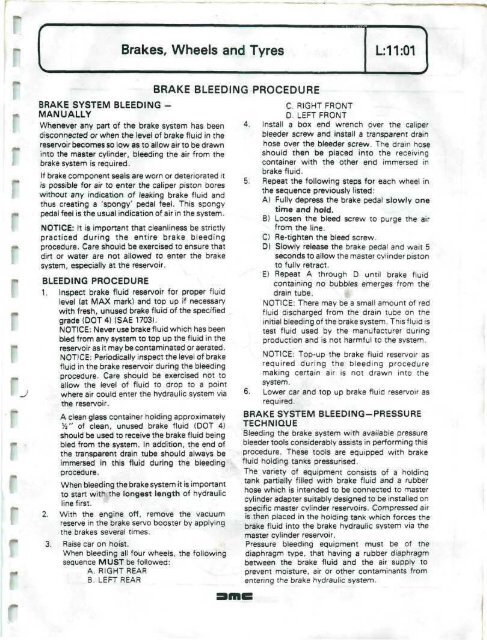You also want an ePaper? Increase the reach of your titles
YUMPU automatically turns print PDFs into web optimized ePapers that Google loves.
r<br />
r<br />
r<br />
r<br />
r<br />
r<br />
i<br />
r<br />
r<br />
r<br />
Brakes, Wheels and Tyres<br />
BRAKE SYSTEM BLEEDING -<br />
<strong>MANUAL</strong>LY<br />
Whenever any part of the brake system has been<br />
disconnected or when the level of brake fluid in the<br />
reservoir becomes so low as to allow air to be drawn<br />
into the master cylinder, bleeding the air from the<br />
brake system is required.<br />
If brake component seals are worn or deteriorated it<br />
is possible for air to enter the caliper piston bores<br />
without any indication of leaking brake fluid and<br />
thus creating a 'spongy' pedal feel. This spongy<br />
pedal feel is the usual indication of air in the system.<br />
NOTICE: It is important that cleanliness be strictly<br />
practiced during the entire brake bleeding<br />
procedure. Care should be exercised to ensure that<br />
dirt or water are not allowed to enter the brake<br />
system, especially at the reservoir.<br />
BLEEDING PROCEDURE<br />
1. Inspect brake fluid reservoir for proper fluid<br />
level (at MAX mark) and top up if necessary<br />
with fresh, unused brake fluid of the specified<br />
grade (DOT 4) (SAE 1703).<br />
NOTICE: Never use brake fluid which has been<br />
bled from any system to top up the fluid in the<br />
reservoir as it may be contaminated or aerated.<br />
NOTICE: Periodically inspect the level of brake<br />
fluid in the brake reservoir during the bleeding<br />
procedure. Care should be exercised not to<br />
allow the level of fluid to drop to a point<br />
where air could enter the hydraulic system via<br />
the reservoir.<br />
A clean glass container holding approximately<br />
W of clean, unused brake fluid (DOT 4)<br />
should be used to receive the brake fluid being<br />
bled from the system. In addition, the end of<br />
the transparent drain tube should always be<br />
immersed in this fluid during the bleeding<br />
procedure.<br />
When bleeding the brake system it is important<br />
to start with the longest length of hydraulic<br />
line first.<br />
2. With the engine off, remove the vacuum<br />
reserve in the brake servo booster by applying<br />
the brakes several times.<br />
3. Raise car on hoist.<br />
When bleeding all four wheels, the following<br />
sequence MUST be followed:<br />
A. RIGHT REAR<br />
B. LEFT REAR<br />
BRAKE BLEEDING PROCEDURE<br />
C. RIGHT FRONT<br />
D. LEFT FRONT<br />
4. Install a box end wrench over the caliper<br />
bleeder screw and install a transparent drain<br />
hose over the bleeder screw. The drain hose<br />
should then be placed into the receiving<br />
container with the other end immersed in<br />
brake fluid.<br />
5. Repeat the following steps for each wheel in<br />
the sequence previously listed:<br />
A) Fully depress the brake pedal slowly one<br />
time and hold.<br />
B) Loosen the bleed screw to purge the air<br />
from the line.<br />
C) Re-tighten the bleed screw.<br />
D) Slowly release the brake pedal and wait 5<br />
seconds to allow the master cylinder piston<br />
to fully retract.<br />
E) Repeat A through D until brake fluid<br />
containing no bubbles emerges from the<br />
drain tube.<br />
NOTICE: There may be a small amount of red<br />
fluid discharged from the drain tube on the<br />
initial bleeding of the brake system. This fluid is<br />
test fluid used by the manufacturer during<br />
production and is not harmful to the system.<br />
NOTICE: Top-up the brake fluid reservoir as<br />
required during the bleeding procedure<br />
making certain air is not drawn into the<br />
system.<br />
6. Lower car and top up brake fluid reservoir as<br />
required.<br />
BRAKE SYSTEM BLEEDING-PRESSURE<br />
TECHNIQUE<br />
Bleeding the brake system with available pressure<br />
bleeder tools considerably assists in performing this<br />
procedure. These tools are equipped with brake<br />
fluid holding tanks pressurised.<br />
The variety of equipment consists of a holding<br />
tank partially filled with brake fluid and a rubber<br />
hose which is intended to be connected to master<br />
cylinder adapter suitably designed to be installed on<br />
specific master cylinder reservoirs. Compressed air<br />
is then placed in the holding tank which forces the<br />
brake fluid into the brake hydraulic system via the<br />
master cylinder reservoir.<br />
Pressure bleeding equipment must be of the<br />
diaphragm type, that having a rubber diaphragm<br />
between the brake fluid and the air supply to<br />
prevent moisture, air or other contaminants from<br />
entering the brake hydraulic system.


